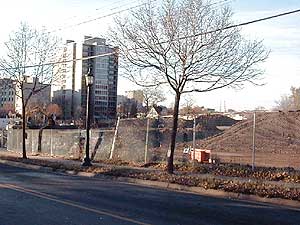Gopher Oil site being cleaned up, after decades of complaints
November 25, 2002
 |
| The Gopher Oil site near Prospect Park in Minneapolis is being cleaned up (MPR Photo/Dan Olson) |
Minneapolis, Minn. — Prospect Park neighborhood resident Florence Litman remembers the reception from state pollution control officials 20 years ago, when she told them about the oil and pesticides spilled on the land in her neighborhood.
"They said, 'Lady, why don't you find something else to worry about, something else to keep you busy? There's nothing wrong with that site, that site is clean,'" Litman recalls. "I said, '(There's) been oil there since 1906,' and they said, 'Ah, oil, that's nothing.'"
It wasn't the first bureaucratic brush-off for Litman and generations of neighborhood residents. They've been complaining about the site since 1910, just a few years after the first oil and chemical business started operations here.
 | |||
The Gopher Oil site gets its name from one of the former owners. Some call it the Unocal site, named after the multinational petroleum company that owned the property for a time. Now, it's in new hands. Neighborhood resident Dean Lund is pleased with the latest turn of events.
"They're moving everything that's polluted off this site, and they're testing as they go to make sure they get it all," says Lund.
Prospect Park is a residential area up the hill from the Minneapolis campus of the University of Minnesota. Winding streets are lined with middle-class homes on tree-filled lots that include the landmark Witches Hat water tower. Interstate 94 slashes through the center of the neighborhood. The freeway erased dozens of homes, but somehow spared Gopher Oil.
Now things have changed. Workers are carting away 70,000 tons of soil laden with pesticides and oil. It's being trucked to one of several lined hazardous waste landfills in the Twin Cities, where it'll reside in perpetuity. Fresh fill is being brought in.
 | |||
Unocal started the cleanup. They punched holes in the ground, hoping fresh air, water treatment and some soil removal would be enough to eliminate the toxins. But Dean Lund says that approach would have taken a lifetime.
"Unocal was in the process of cleaning it up with a very slow technology, that would have literally taken decades," says Lund.
Decades of delay thwarted residents' efforts to make the site suitable for housing. Early in the last century they banged their heads against city hall's door, wondering why officials wouldn't rezone the property. Later, it became known that a key city official was a major company shareholder.
Then in the 1980s, the cleanup was delayed by public policy. Dr. Michael Greenburg says fear of lawsuits delayed treatment of tens of thousands of polluted sites around the United States.
Greenburg directs the National Center for Neighborhood and Brownfield Redevelopment at Rutgers University. Owners of polluted sites, he says, faced triple damages if a court could be convinced the toxins harmed the health of people at or near the site.
"Real estate developers were very reluctant to take on any kind of contaminated site, because they were afraid of lawsuits that would have been incredibly expensive for them," says Greenburg.
Congress changed that policy, and the Prospect Park neighbors' persistence paid off. By the mid-'90s they had new tools -- and new friends. A string of sympathetic city council members, including Kathleen O'Brien, helped with rezoning the land. Meanwhile, cities, counties and states embraced brownfield cleanup. The new Gopher Oil site owner has strung together loans and grants that cuts down the cleanup time from decades to months.
Kathleen O'Brien, now a vice president at the University of Minnesota, says citizen action was the key ingredient.
"It really was the commitment of citizens -- and not regulatory agencies -- that brought about this change," says O'Brien.
Cleaning the Gopher Oil site will cost nearly $5 million. That's about average, state officials say. When done, the parcel will be removed from the state's Superfund list, a collection that once numbered 200 seriously polluted parcels of land in Minnesota. State officials say by the end of the year, the list will contain fewer than 100 sites.
|
News Headlines
|
Related Subjects
|
